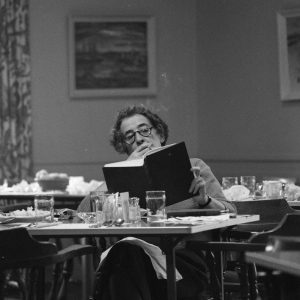Involuntary Euthanasia

Hannah Arendt, Wesleyan University, c. 1961/62
Involuntary Euthanasia. Hannah Arendt’s work has warnings about totalitarianism; sadly, they seem today to apply to democracies also
By Luis Feduchi
It is surprising that the Aktion T4 program, forerunner of the plan to exterminate the Jewish people, is unknown to many Germans today. It is surprising because German society is not known for having turned its back on that fatal episode in its history, but also because an embrace of the idea that confronting the past ensures that it will not repeat necessitates the study of the past with as much or more diligence than the horror that it wrought.
The program to which I refer, whose euphemistic name perhaps reflects the difficulty of revealing its objective, was a death sentence exacted without consent upon terminally ill patients –a law whose title should have been that of this article. The ultimate name chosen for the action is an acronym of the Berlin street address where the plan was conceived: Tiergartenstraße 4.
In 1961, 20 years after her exile to the United States and with pride in her American citizenship (not so in her nationality), German-born Hannah Arendt was commissioned by The New Yorker to cover the trial set to take place in Jerusalem against the alleged war criminal Adolf Eichmann, the uncontroversial Nazi civil servant who had been found in Argentina a year earlier. The report would be published in installments in five successive editions of the magazine and later compiled in the book Eichmann in Jerusalem.
In her chronicle, Arendt refers, without mentioning it by name, to the involuntary euthanasia program as such: “There is the well-known fact that Hitler began his mass murders by granting ‘mercy deaths’ to the ‘incurably ill’, and that he intended to wind up his extermination program by doing away with ‘genetically damaged’ Germans (heart and lung patients).” [i]
A month after the Covid-19 pandemic began, while rereading this impeccable reportage, I noticed the parenthetical addendum “(heart and lung patients)”, which Arendt may have inserted to clarify which of her compatriots Aktion T4 targeted. It seems she wanted to make clear that Hitler’s operation extended beyond race and ideology, thus demonstrating that he had little or no compassion for the elderly or for those of weak health, those we have now come to refer to as the vulnerable.
Associating vulnerability with the fact of being explicitly marked to die is something that cannot leave us cold. When vulnerability is not only a product of congenital or unexpected disease, when ethnicity or social conditions become a shortcut to such vulnerability, when opposition to a political regime, as with many refugees, pushes groups into that state of fragility and lack of protection, we read Arendt’s words as an undeniable exhortation to what may be may transpire when the economic and social crisis exacerbated by Covid-19 soon manifests in full.
Whether it’s the kids children shot at by lockdown police in an East African slum, or the elderly who died at home for fear of going to crowded health centers during the peak of the pandemic in Southern Europe; be they the long-term deaths of despair caused by the loss of income that freedom of movement at least guaranteed, or the fatalities of the ongoing civil wars whose desperate conditions further intensify during confinement – what we cannot forget is that confinement, a measure that has placated the outbreak of the pandemic, can also be an instrument of dubious protection of citizens when not only in the hands of totalitarian authoritarianism, but also in the face of the social injustice that not even the most progressive countries have eradicated.
There are hardly any countries devoid of well-founded accusations of abusing the power that confinement has allowed. In this climate, it is surprising to see demonstrations fueling conspiracies in Germany or allegations of mismanagement in Spain and Italy, when in India, Brazil, Russia, Turkey, Burma, the Philippines – not to mention the United States and China, where uprisings in the former and unrest silenced are everyday news – the impact that confinement is having on minorities and abuse of power is adding to the daily toll. The risks do not come only from populist and authoritarian leaders, but also from uncontroverted civil servants and the complex state machinery of purportedly democratic regimes.
If, as Jürgen Habermas said, “the task of those who dedicate themselves to the profession of thought is to shed light on the crimes that were committed in the past and to keep awareness of them alive”, then Arendt’s work may suffer spikes of inattention as to the possible repetition of crimes that are difficult to foresee and almost impossible to believe. But what should surely remain in focus is the way in which even a brief passage from her oeuvre is able to shake us alert and inspire our vigilance to prevent such colossal crimes from happening again.
[i] Hannah Arendt, Eichmann and the Holocaust (London, Penguin, 2005), p.116.